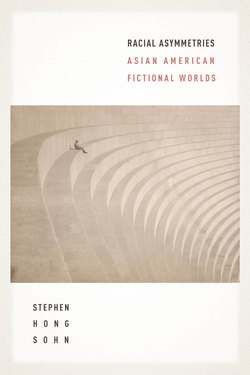Читать книгу Racial Asymmetries - Stephen Hong Sohn - Страница 9
На сайте Литреса книга снята с продажи.
Оглавление2. When the Minor Becomes Major: Asian American Literary California, Chicano Narration, and Sesshu Foster’s Atomik Aztex
This chapter shifts from the white-Asian paradigm discussed in the first chapter to an investigation of how and why Asian American writers include other racial minority groups in their fictional worlds. Chapter 1 called attention to a racial paradigm that substantively undergirds Asian American studies: white consciousness in relation to immigrant exclusion. As scholars such as Lisa Lowe, Ronald Takaki, Sucheng Chan, and numerous others have revealed, whiteness signified the ultimate racial criterion of American citizenship and was defined in part through its opposition to the Asian, the forever foreign subject. Despite the early barriers that Asian immigrants and their children faced in America, the economic opportunities that emerged consistently encouraged successive populations and generations to make the arduous journey across the Pacific Ocean through whatever methods possible. The post-1965 period ushered in a new era for Asians and Asian Americans as immigration restrictions were lifted, but chapter 1 also reveals the ways in which racial minorities still suffer from different and perhaps subtler forms of prejudice. I employ Chang-rae Lee’s Aloft to illustrate how a white narrative perspective can occlude the significant adaptive challenges faced by people deemed to be minorities; this novel reminds us that our attention to racially inflected social inequalities must continue and exposes the pitfalls of postracial ideology.
Examining these social, cultural, and interracial contexts rightly forms one critical basis of our discipline, but race and ethnic studies scholars continue to reveal the complicated contours of exclusion, especially as it occurs with respect to multiple minority groups. In a special issue of PMLA on comparative racialization, the literary critic Shu-mei Shih encourages scholars and critics to consider racial formations as inherently interconnected but not necessarily symmetrical or equatable in their constructs. In this chapter, I am most interested in the representation of one comparative minority racial axis—that of the relationships forged and the antagonisms that erupt between Chicanos and Asian Americans.
As one of the states closest to Asia, California consistently beckoned to Asian migrants as a robust center for numerous industries, ranging from agriculture to technology. At the same time, California’s economic history cannot be constituted solely from the perspective of Asian labor, as historians such as Tomás Almaguer and Kevin Starr have shown. Indeed, California’s vexed past includes the colonial exploitation and enslavement of indigenous populations, the systematic restructuring of the agricultural industry through the recruitment of transnational Mexican guest workers, and the influx of African American workers during the Second Great Migration. In relation to these multiracial contexts, Asian American writers do engage with such intricate social and historical formations within their representational terrains. I am particularly attentive to writers such as Carlos Bulosan, Brian Ascalon Roley, Bhira Backhaus, and Sesshu Foster, all of whom explore the connections and complications that arise between Asian American and Chicano characters. These writers present an exceptional subset within the Asian American literary archive in that their fictions conspicuously depict characters of other racial minority populations.
